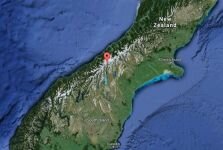PERALIYA: Head guard Wanigaratne Karunatilleke was one of the few people to survive when a wall of water slammed into the Ocean Queen train on Sri Lanka’s south coast a decade ago, killing around 1,000 people.
On Friday the 58-year-old, who is still haunted by memories of the passengers he could not save, flagged off the train for a special journey to commemorate the victims of the Asian tsunami, Sri Lanka’s worst ever disaster.
“I am sad so many of my passengers died that day,” he told AFP.
“But I am happy we are remembering the victims and holding religious services.”
The Ocean Queen Express was rebuilt after the tsunami and has become a symbol of the disaster in Sri Lanka and was at the centre of sombre commemorations for the country’s 31,000 victims on Friday.
Survivors and relatives of the dead boarded the train early Friday morning in Colombo and headed to Peraliya, the exact spot around 90 kilometres (56 miles) south of Colombo where it was ripped from the tracks.
Mourners laid flowers and lit incense at a memorial for some 1,270 people buried in mass graves on Peraliya beach.
Buddhist, Hindu, Christian and Muslim ceremonies were held in Peraliya to commemorate victims across the country.
Remembrance services were held around Sri Lanka on Friday, while President Mahinda Rajapakse observed his traditional two minutes’ silence.
Damayanthi Abeywardene was on the train, which runs from Colombo to Matara, in 2004 with her two daughters, then aged 16 and 19.
She was there to give thanks for their survival and remember those who were less fortunate.
“No one should have to see what we saw. The struggle of people trying to stay alive… The hundreds of corpses,” the retired school teacher said, breaking down in mid-speech.
Abeywardene recently published a book about her harrowing escape, but said she and her daughters had never discussed their ordeal in the past 10 years because it was too traumatic.
– ‘I wish I had known’ –
The tsunami first hit Sri Lanka’s southeastern coast, travelling across the island at about 500 kilometres (300 miles) an hour and killing 31,000 people.
Sri Lanka had not been hit by a tsunami in living memory before 2004 and the tragedy became the country’s worst natural disaster.
Karunatilleke blames the huge loss of life on a lack of knowledge about tsunamis.
He says a smaller wave that brought the train to an abrupt halt shortly before the tsunami hit could have acted as a warning to people to flee to higher ground.
He overruled the signalling system after the first wave and ordered the driver to move, but by then it was too late.
When the tsunami hit, he became trapped inside a compartment that was floating in the water, managing to escape through a window.
“We had about 15 minutes to move the passengers to safety. I could have done it. We had the time, but not the knowledge,” Karunatilleke told AFP.
Disaster management minister Mahinda Amaraweera said early warning systems were now in place.
Shanthi Gallage was also among the few who survived the train tragedy along with her eldest daughter, but her younger daughter, then 13, is still listed as missing.
“I think my husband died, but my daughter is still alive somewhere,” the 55-year-old told AFP on board the Ocean Queen. “I will find her some day.”
Every year on December 26, Karunatilleke stops at the exact same spot to pay his respects to his departed passengers.
He recalls rescuing a small girl and boy from the floodwaters and placing them inside a train compartment only to see it smashed minutes later.
“I will remember those two children for the rest of my life” he said.
“I did not know about tsunamis then and neither did anyone else on board.
“I wish I had known… I really feel bad that I was not able to save those lives.”






